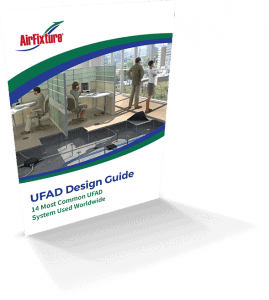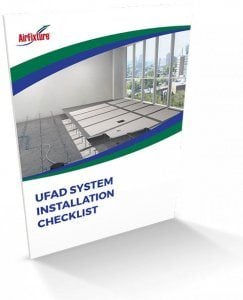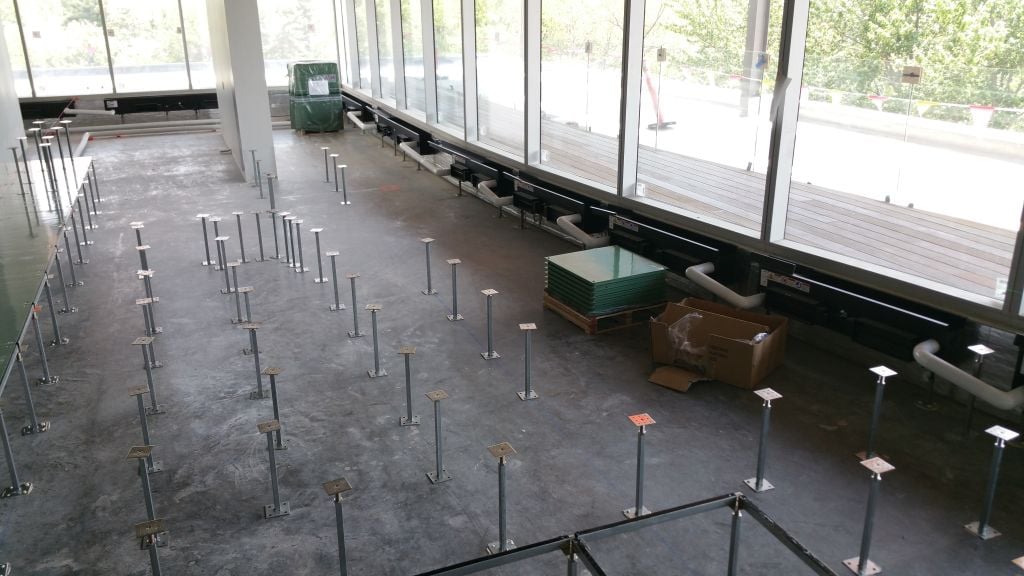How Raised Access Flooring Systems Improve Building Design Flexibility
Today’s economy continues to see a relative flatlining of the commercial building sector. Occupancy growth is continuing to slow, with one study...
Floor, wall and ceiling mounted to meet your unique project design.
4 min read
Joe Hullebusch : Sep 5, 2018 12:00:00 AM
There's no question that raised access floors (RAF) are enjoying a meteoric rise in popularity. Raised access floors now cover approximately 25,000 square kilometers in Europe, Asia-Pacific, and North America, and the market is on track to reach $1.5 billion by 2025. Further, Arizton argues "raised access flooring market size to cross revenues of $900 million by 2025."
There's a reason for this trend. Because RAF allows you to route building services - HVAC, power & cabling, plumbing, etc - through the underfloor plenum void, it opens up a world of possibilities for lowering operating costs and improving occupant comfort and satisfaction.
Both full-height and low-profile types offer a variety of benefits for both new builds and the conversion of existing buildings, including:
Each building type has a unique set of challenges. And while these RAF benefits apply equally to all categories, some will have a greater value than others depending on the type of building. Let’s examine five building types and how they benefit from a raised access flooring system.
“Recent data from the U.S. Census Bureau shows construction costs went up by 17.5% year-over-year from 2020 to 2021, the largest spike in this data from year to year since 1970.” According, to Kingspan, “Raised flooring enables suspended ceiling plenums to be reduced in depth or eliminated. The reduced slab to slab height could save the equivalent of one free story for every 12, with external façade costs reduced by approximately 10%." So, find a brilliant solution to those increased costs, and consider underfloor air today.
For commercial property owners, containing costs is critical towards maintaining profitability. With construction costs rising 4.2% annually and commercial buildings accounting for 12% of all U.S. energy consumption, property managers under enormous pressure to keep both capital and operational costs in check.
Raised access floors reduce costs on both fronts.
A building designed to incorporate RAF can have the same interior volume with a lower overall height thanks to a 10% average reduction in floor-to-ceiling heights. Because RAF reduces your typical floor-to-ceiling height by several inches, these increments will quickly add up over the total height of the building, effectively giving you an extra floor. Therefore, if your plans call for a 12-story building, your building will have the equivalent height to an 11-story building without using RAF - dramatically lowering your construction and operational costs.
The profitability of your building depends on your ability to reduce tenant churn and keep your vacancy rates low. Since RAF in tandem with underfloor air distribution improves occupant comfort, reduces cost savings, and improves layout flexibility, you’ll be well positioned to attract and retain key tenants for the long term.
Unfortunately, universities and schools in the U.S. are typically among the oldest buildings still in continuous operations. With public education funding falling and attendance rising, educators are forced to keep older facilities operating for longer periods of time. In 2010, it was estimated that the average age of U.S. schools is 42 years.
Raised access flooring can revolutionize indoor air quality, thermal comfort, and wellness in older buildings. UFAD systems cost less to operate yet deliver an ASHRAE-recognized 20% ventilation effectiveness improvement and provide greater user control over thermal zones.
Overall, the opportunities for improving indoor air quality means that educators can improve the operational lifespan of their facilities and ensure occupant comfort for the foreseeable future.
Full-height raised access flooring systems facilitate the use of underfloor air distribution systems, which are ideal for large-volume event spaces that see large numbers of visitors. A key concern with these types of buildings - from sports arenas to large convention spaces - surrounds the high cost of delivering and conditioning air inside the environment.
There are a couple of ways UFAD lowers energy costs. First, the system requires considerably less ductwork to operate. With less ducts to navigate, the airflow faces much less resistance, so less energy is spent on the fan horsepower needed to overcome this resistance. As noted earlier, ASHRAE awards UFAD systems a 1.2 CFM (cubic feet per minute) efficiency modifier, meaning that a UFAD system is 20% more efficient at delivering airflow efficiency than a traditional overhead system.
Second, UFAD works by introducing airflow at floor level and takes advantage of the fact that heated air will rise naturally to the top of the room. This means you’ll only have to worry about conditioning the first six feet (the occupied zone) rather than introducing heated air at the top of the room and forcing it down to ground level at extra cost. So you’ll save the costs of no longer having to condition the entire volume of the room.
A key feature of RAF is that it incorporates customized raised floor panels that give you an unmatched degree of flexibility to manage cabling and power. It’s an ideal setup for data centers, since the panels allow easy access to the underfloor plenum to route cables directly from point to point, without having to navigate around obstacles. As a result, you’ll save significantly on the costs of cabling and connecting terminals.
For casinos, being able to quickly change the layout of their gaming floors is critical. Since these facilities tend to be open all hours, staff need to be able to be able to move gaming machines in a short period of time.
Raised access floor panels with integrated power terminals mean that machines can be placed virtually anywhere; adding or moving power terminals is simply a matter of swapping out floor panels and placing them when needed.
Finally, keeping the indoor air quality at comfortable levels is another ongoing challenge for casinos. As these facilities are among the last to typically permit smoking, it’s a constant battle to ensure that customers aren’t deterred by suspended smoke particles in the air.
UFAD solves this problem by acting as an air displacement system. Fresh air enters the room from floor grilles, and rises up to the ceiling - pushing any suspended smoke particles safely up and out of the occupied zone. This results in dramatically improved indoor air quality and ensures that one guest’s smoke won’t compromise the enjoyment of someone sitting at an adjacent gaming terminal.
AirFixture is a recognized industry leader providing innovative underfloor air distribution products and solutions for office buildings, casinos, event spaces, and government facilities around the world. Contact us today to speak to a UFAD expert and learn how this revolutionary system can deliver unrivaled air quality and significant energy and operational cost savings to your facility.

Today’s economy continues to see a relative flatlining of the commercial building sector. Occupancy growth is continuing to slow, with one study...

Raised flooring has become an increasingly popular option for commercial and government spaces over the years. From data centers utilizing the style...

The control systems that connect every aspect of commercial buildings are vital to the success of a property owner. From electrical wiring to air...